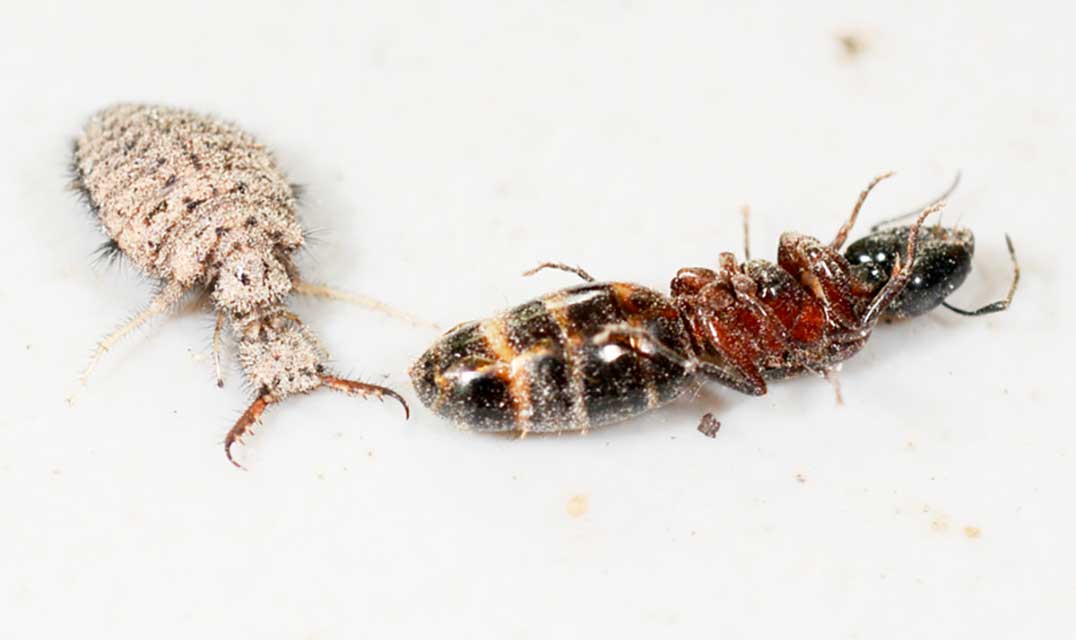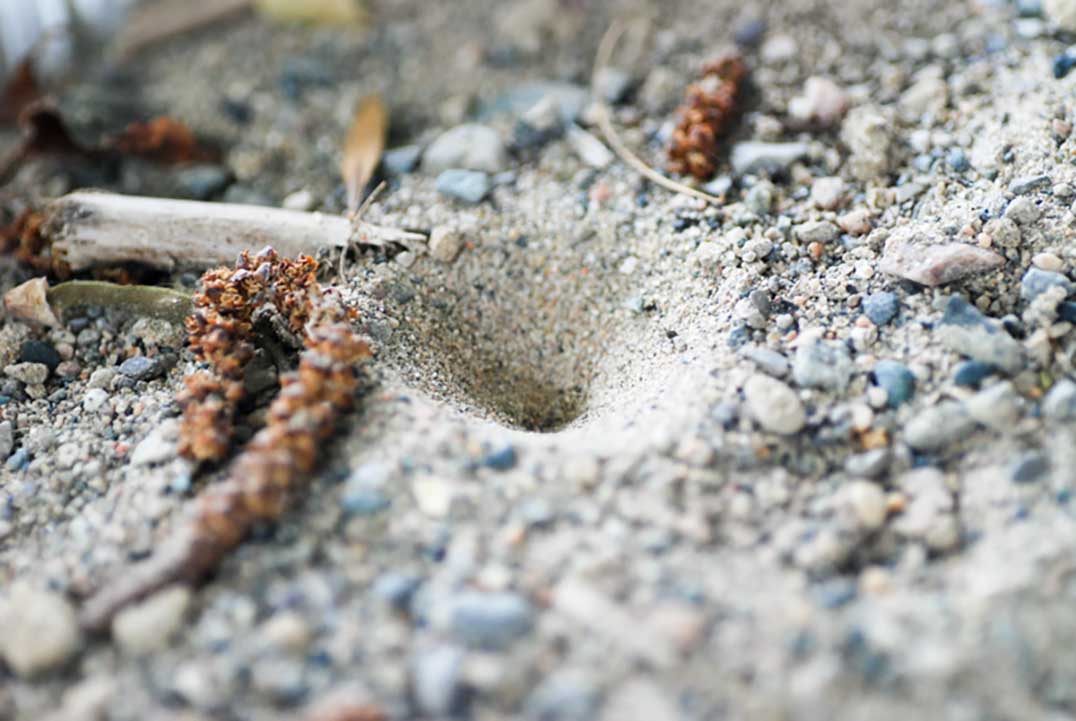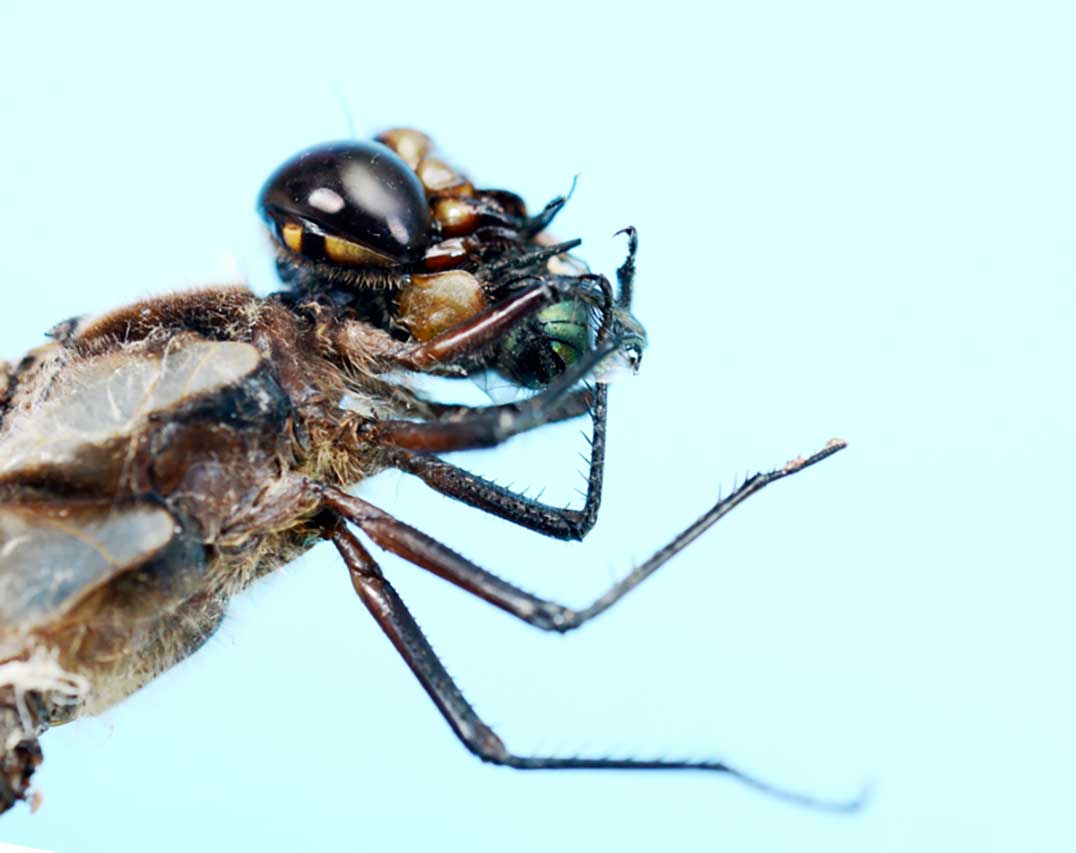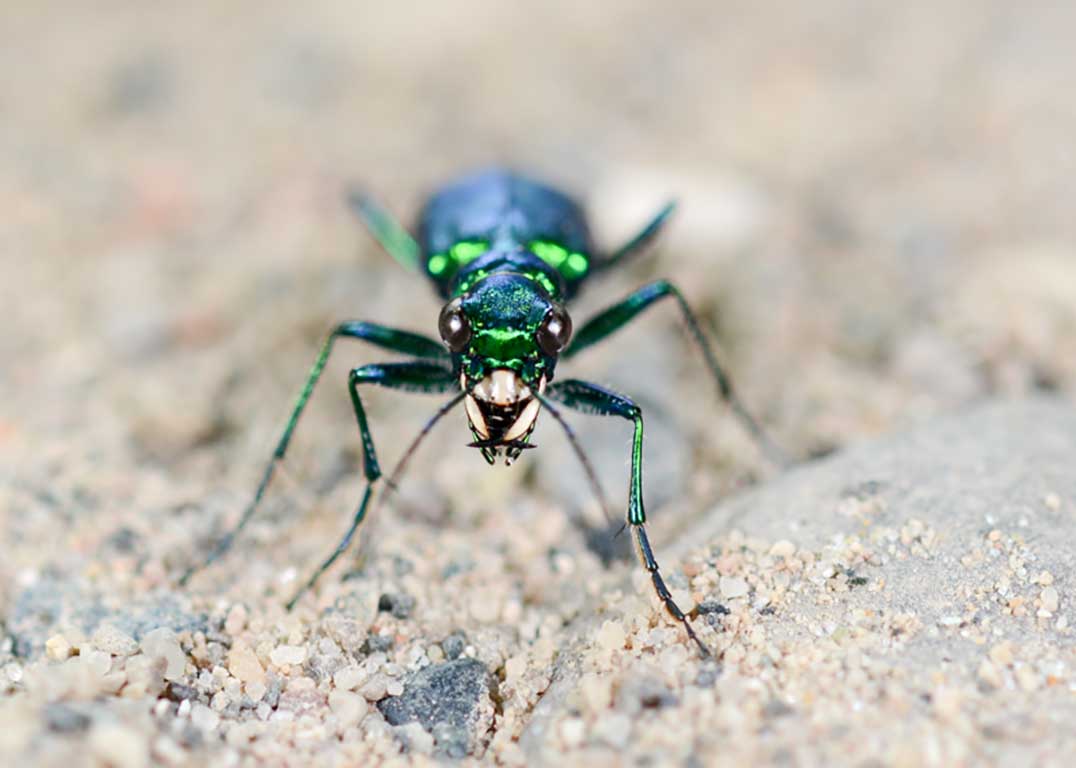(Ant lions, dragonflies and tiger beetles, that is)
by Joe Shorthouse, retired Laurentian University entomologist and summer resident of Batman’s Campground
MANITOULIN—Most people are fascinated by at least a few kinds of insects such as butterflies, ants, ladybugs or honeybees and frequently want to learn more about them. As a result, entomologists (scientists who study insects) are frequently asked questions such as ‘what kind of bug is this,’ ‘what good is this bug’ or ‘how do I get rid of this bug?’
Retired entomologists like myself, who still enjoy talking, photographing and writing about insects, such as those on Manitoulin Island, are no exception and friends, relatives and youngsters at Batman’s Campground near Sheguiandah regularly bring me critters to identify or ask questions.
Another common question is ‘what is the best hunter of other insects on Manitoulin Island.’ After giving this some thought, my three-part answer is ‘ant lions, dragonflies, and tiger beetles.’ In this article, I explain the reasons for my choices and in doing so celebrate their beauty, remarkable adaptations, quirks and personalities and the fun I have in searching for them and observing their lives.
Each of these three insects is a ferocious predator; that is, they kill and feed on other insects. About one quarter of all the many thousands of different kinds of insects on Manitoulin Island are predacious while the rest eat plants or dead things.
One of the many reasons these insects are so successful is that the immature stages feed in different places and on different foods than do the adults. This is a big advantage in diverse ecosystems because it means that the immatures do not compete with adults for the same food. This will become evident as we examine feeding by antlions, dragonflies and tiger beetles.
Antlions

There are about five species of antlions in Ontario. The meaning of the name ‘antlion’ is unknown, but it likely refers to ants forming most of the prey and the suffix ‘lion’ may merely suggest hunter or destroyer.
Even though antlions are one of the least observed insects on Manitoulin, they are one of the most fascinating because of the fiercely predatory habits of their larvae and their way of catching food. Antlions dig funnel-shaped pits in the ground which they use to ambush passing ants or other small insects.
The larvae of antlions live in dry places along the edges of lakes or streams where they wait for passing prey. Sometimes referred to as ‘doodlebugs’ they leave meandering trails in sand or powdery soils as they wander around looking for a place to settle. I found the ones in these photographs on the sand dunes of Providence Bay.

Antlion larvae are grotesque-looking with an oversized, flattened head, long mobile necks and a fat body covered with bristles. They have two enormous, sickle-shaped jaws with sharp projections. Full-grown larvae are about 1 cm in length and the death traps they make are about 5 cm wide at the edge and 4 cm deep.
Having chosen a site for its pit, the larva starts to crawl backwards using its abdomen as a plough to shovel up the sand. It places heaps of sand on its head and then with a quick jerk, shoots each pile outwards. As it moves in a circular manner, a pit slowly forms with sides of the slope forming an angle such that they collapse with the slightest disturbance.
The larva settles at the bottom with only its jaws protruding. Ants that tumble into the pits find little footing and the waiting antlion speeds up the prey’s demise by flinging sand at it causing a land slide that brings the ant to the bottom where they are quickly seized.
Antlions do not have mouths, but instead they have hollow jaws which they use to suck out the body fluids of their prey. Death is instantaneous as the larvae quickly inject venom and digestive juices into the victim then suck out the nutritious goo.
After fluids of the prey are consumed, the dry carcass is flung out of the pit and the antlion readies itself for the next victim. Larvae can survive long periods of famine because of their slow metabolic rate. They commonly spend three years in the larval stage before turning into adults that live about three summer weeks.
Antlion adults are long, slender insects that look like damselflies (antlion adults have clubbed antennae whereas damselflies have inconspicuous antennae). They are weak fliers with soft bodies and two pairs of oval, mesh-like wings that are held roof-like over the backs when at rest. They feed on small insects in the vegetation at night and search for mates and sites to lay eggs.
If you come across antlion pits from May to October, try sifting the sand at the bottom of the cones with your fingers, or gently scoop out sand at the base with a spoon. When you have had a look at the ungainly creature, release it back onto the sand and watch it make a new pit.
Dragonflies

Dragonflies belong to an ancient group of insects that were flying around millions of years ago before dinosaurs walked the earth. Although the origin of the name dragonfly is a mystery, it is an appropriate description for these voracious predators that are outstanding hunters in both the nymph and adult stages. There are about 130 species of dragonflies in Ontario.
The reason we usually see adult dragonflies around streams, lakes or ponds is that the immature stages, called nymphs, are aquatic. They live on the bottom of ponds and lakes where they hang out on vegetation waiting for their prey. When prey such as mosquito larvae and worms get close enough, they unfurl their mouthparts which shoot out past the head and capture the prey in their jaws.
The gills of dragonfly nymphs are inside their anus. That’s right—they breathe through their rear ends. In addition, they bring water inside their anus then force it out under high pressure which shoots them forward when capturing prey. Dragonfly nymphs had invented jet propulsion long before humans.
When the nymphs are full grown, they crawl out of the water onto rocks or vegetation. Their body skeleton splits along the top side and the four-winged adult wriggles free.

As everyone who has watched adult dragonflies knows, or tried to catch one, they are masters of flight. They are the most elegant, agile flying machines on Manitoulin Island. Each of their four wings can be moved independently.
Not only do they flap their wings up and down, they can rotate them backwards providing more flexibility than any other insect. They can fly straight up or straight down, hover or make hairpin turns at full speed or in slow motion. They can even fly backwards!
They catch their prey midair by flying at speeds of about 10 km per hour. Large species can accelerate to about 40 km per hour. Their legs face forwards to form a basket which they use to scoop up insects and eat them without landing. Few insects can escape their grabbing limbs that clutch prey before crushing it with powerful jaws and swallowing it.
Dragonflies are not picky eaters as they will eat any insect they can catch including other dragonflies. They prefer mosquitoes, gnats and small flies but will also eat butterflies, moths and bees.
Having legs shaped like baskets prevents dragonflies from walking or running; they can only be used for hanging onto plants or hard objects.
Dragonflies also have extraordinary vision thanks to two huge compound eyes which give them nearly 360o vision and the ability to detect the movement of flying insects some distance away. Each compound eye has about 30,000 individual eyes.
Tiger beetles

There are about 15 species of tiger beetles in Ontario. All have bulging eyes, long, slender legs and formidably large three-toothed jaws that are conspicuously crisscrossed at their tips. One species of tiger beetle I commonly find on Manitoulin is bright green. Others are black with patterns of light lines running across and up and down their backs. It is the striped patterns on the upper surface and their ferocity that give tiger beetles their name.
Among beetles, tiger beetles are perhaps second only to ladybugs as favourites of nature-loving people. These colourful beetles which are about 12-15 mm in length are found on open ground such as sunny woodland paths, sand dunes and beaches.
The larvae of tiger beetles larva are among the most other-worldly creatures one can imagine. They have long, narrow, hump-backed, grub-like bodies that hang from the head at a 90° angle inside cylindrical, vertical burrows made in firm patches of soil. Their large heads bear two long, sickle-shaped jaws that point upwards and three pairs of eyes giving them the appearance of a face with congenital birth defects.
Tiger beetle larvae rest with the tops of their heads flush with the ground surface. When small insects pass by, the larva lunge from its burrow and grabs the victim with its jaws, then pulls it into the burrow to be devoured. They are prevented from being yanked out the burrow by larger, struggling prey by a hump on the dorsal side that functions to anchor the larva against the side of the burrow.
Adult tiger beetles display an unusual way of pursuing their prey whereby they alternatively sprint quickly towards their prey, stop, look around then renew their attack. This may be because some beetles have been clocked running at a speed of 8 km/h, or about 100 body lengths per second, which is too fast for their eyes to accurately process images.
Tiger beetles are also fast fliers and their reaction time is the same as houseflies. They quickly run or fly when you approach which makes them hard to sneak up on for a close look, or catch them. They usually fly about 10-20 m, land, then quickly turn around to see if you approach again.
Tiger beetles are active on sunny days in open, barren areas where they can easily see their prey. They never seem to stop moving on warm, sunny days as they are always looking for food and mates, while avoiding enemies that might eat them. On cool days, they raise their body temperatures by basking in the sun and keep their bodies close to the warm ground.
If the ground becomes too hot, they regulate their body temperature by standing on their tiptoes to keep the body as far from the hot ground as possible. This is like you and me running barefoot on a hot beach down to the water.
The three insects highlighted in this article are among the most fascinating on Manitoulin Island and watching and learning about them can be as rewarding for outdoor enthusiasts as is gardening, bird watching or studying plants.




